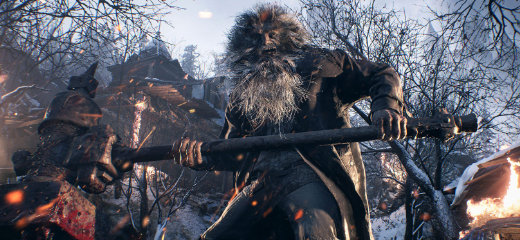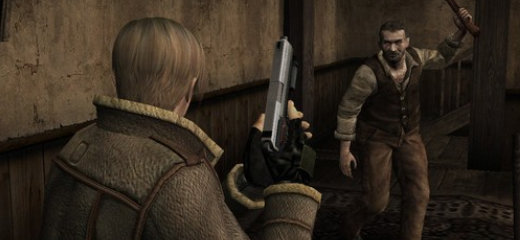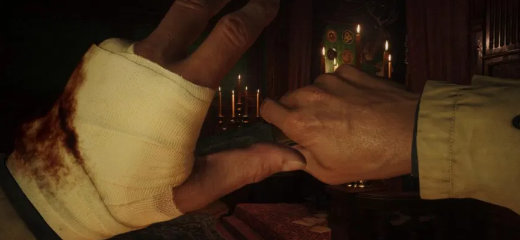I like Resident Evil Village.
I like the “theme park”-style structure of the game, seperating a number of lean, diverse and linear thrills with an invitation to get a little exploring and treasure hunting done in the village in between. I enjoy the restless, shlocky energy that you get going between the four big bads. I enjoy that the game doesn’t run out of steam halfway through like RE7 did, even if it has a section that drags on overlong – instead of petering out, the game climaxes three times, which is a good problem to have. I like the selection of rather exotic and well-realised firearms. I like how effortlessly the game runs on my aging hardware1, while still looking completely wonderful. I really like the Duke.
Admittedly, I mostly like it by comparing it to RE7, instead of a good game - even so, it’s far from charmless. However, I think that the fundamental combat formula we see in Village is rather flawed. After the requisite slow intro section that seems to be holistically designed to torment speedrunners, the first real fight in Village begs comparison to RE4’s first big fight, and for me, it came up sadly lacking.
 “Where’s everyone going? Old Yarnham?”
“Where’s everyone going? Old Yarnham?”
The most addictive, eternally well-tuned thing about RE4’s combat system is the fact that headshots and kneeshots reliably cause staggers, which then open up a context-sensitive melee which produces crowd control. This is an immediately satisfying rhythm that we are more than happy to do all day. RE4 never truly feels like it drags, even though the island chapter unquestionably does, because we are simply always excited to enter a room, shoot a head, kick its owner, and repeat. RE4 is possibly the only game where you can be disappointed by a headshot messily bursting the head in question - you wanted that big kick, didn’t you?
However, it is predicated on these critical shots being somewhat difficult to achieve. Enemies either move slowly and predictably, or reliably flinch no matter where they’re shot. The difficulty mostly comes from the game being designed for controllers, and having to guide a laser pointer around the screen to line up shots. Even with a mouse awkwardly introduced for the PC ports, this is tricky. You can’t always see the laser pointer (which can be panic-inducing in its own right), and it crucially starts in a specific position relative to the player character instead of the camera when they ready the gun. The speed at which the player can move the laser pointer around varies depending on the gun, but is always fairly slow compared to FPS controls.
This is why the Riot Gun is better than the Striker, in case you were wondering - it readies up pointed at face height, and it has a faster aim speed. The Blacktail also offers faster aim speed, making it effortlessly superior to the Red9 (no, I don’t offer comments on my blog, dummy).
The closer the enemies are, the less likely the player is to be able to line up a headshot in time, making RE4’s combat a constant knife-edge situation where the player is constantly looking to set up their next headshot to buy some safety. I’m not even a huge RE4 fan, mostly due to disliking the series going in that direction after the impeccable REmake, but even I can’t diss its fundamental combat system.
 I know you - you have a gamer’s eye. You are most likely lining the headshot up right now.
I know you - you have a gamer’s eye. You are most likely lining the headshot up right now.
Lycans in RE Village are some of the fastest, fiercest grunt enemies seen in this series. And even still, because we’re using standard FPS crosshair controls, landing headshots on them is for the most part trivially easy, even up close - particularly up close - we’ve practiced on every other FPS game we’ve ever played. There’s a particularly strong aim assist too, if you’re struggling. Therefore, we simply can’t have this satisfying, knife-edge rhythm, even though the game is absolutely dying to be RE4. We are left with a random stagger chance on headshots, if that, a maximum difficulty that requires something like 20 headshots per enemy with starting weapons, and the closest thing we have to the melee crowd control is the ability to push enemies back after blocking - a completely passive and limp mechanic, as is blocking in general2.
This is why I think whoever’s in charge of designing the (inevitable at this point) RE4 remake is in a truly unenviable position. No doubt the task will come to modernize RE4’s controls, in which case they will have to reckon with this problem anew - though honestly, bravo for them if they keep a laser pointer system that feels like absolute unrepentant ass to play on a mouse. Even in order to achieve the flawed combat system seen in Village, every enemy’s behaviour would have to be completely redesigned and every encounter’s layout rebuilt. For action games, we have to start with the controls, and everything else stems from there.
However, I think you can get away with modern, crosshair-style controls in a pure survival horror game like RE2’s remake. Every bullet spent is a careful investment - faced with an enemy blocking a path, we can spend a shot or two to force a stagger and slip past, we can spend a little more ammo to blow out a leg or something and cripple the enemy for later, or we can spend even more ammo to kill an enemy outright. Being able to smoothly and quickly target parts of an enemy reinforce this very well, because the challenge isn’t actually in shooting enemies particularly accurately - the core conceit of the game is in the logistics of managing ammunition, inventory space and resources in the undying struggle to place key items into their proper and loving homes.
Perhaps whispering that survival horror is a better fit for modern controls than horror action is how we can seduce Capcom into making more of the former?
 This impenetrable defense makes Ethan Winters one of Resident Evil’s most powerful protagonists.
This impenetrable defense makes Ethan Winters one of Resident Evil’s most powerful protagonists.
Dead Space was a great game, so was the second, and look at how utterly manic and furious the enemies have to be in order to make up for a more fluid control scheme (which would probably still be considered antiquated now). Note how smart the designers were in thinking up a different way to produce staggers and crowd control - amputations and stasis, the latter mechanic going frankly overlooked these days. Dead Space isn’t quite as tight and elegant as RE4, but it does its own chaotic thing in a thoroughly well-thought out fashion.
I don’t know what the RE team could do here, assuming we’re going to see a small glut of first-person horror action before Capcom inevitably consults its magic eightball for what direction the series goes in next. Let’s be honest with ourselves, they don’t actually need to resolve this at all – if people are roasting this game, it’s for not having an FOV slider and for perhaps not being a survival horror game (did such people completely miss how thoroughly and absolutely this game wants to be RE4’s little brother?), and most likely not for these flawed fundamentals. This gunplay is presumably good enough.
 One exciting potential direction a RE4 remake could go in.
One exciting potential direction a RE4 remake could go in.
They probably can’t go down the route of having absolute hordes of low-HP enemies - such a thing would place pressure on art and engine, both of which are thoroughly admirable in Village, and we’d still need to consider a crowd-control mechanic that’s hopefully better than holding the block button and waiting for something to strike the protagonist’s noodle arms. I don’t think anyone’s in a position to fundamentally change shooter controls these days – even in VR, certain things have already calcified.
Perhaps it is finally time for Gaiden’s rhythm-based combat, where Barry Burton is presumed to be constantly tactically nae-nae’ing his gun, to make a splendid resurgence. I’m only half joking.
-
We currently live in a situation where a full-spec VR setup is cheaper and more accessible than an upgrade from my GTX 1060. If for no reason beyond self-interest, fuck crypto. ↩
-
Boy howdy, let’s not even talk about blocking - a mechanic which expects us to instantly intuit that feral werewolves and massive warhammers the size of our body can be instantly and wholly blocked by flailing our arms up, and which offers nothing interesting even once we know how it works. ↩